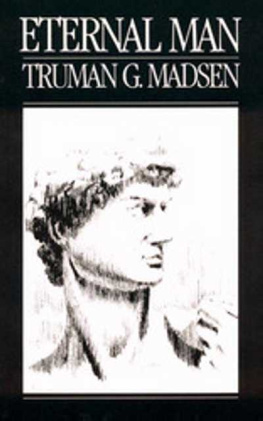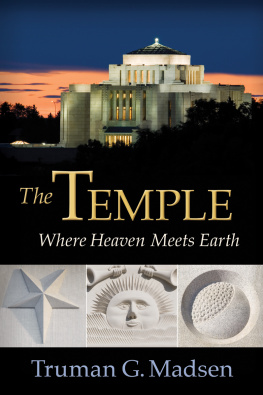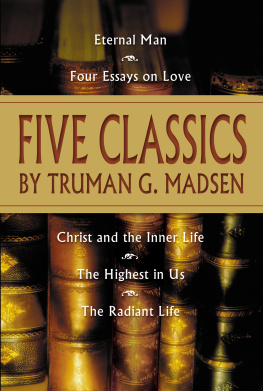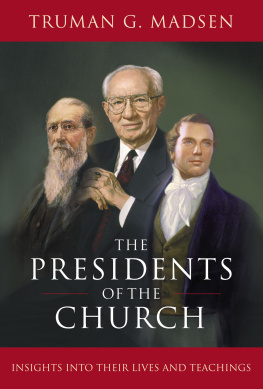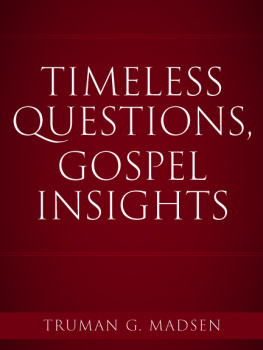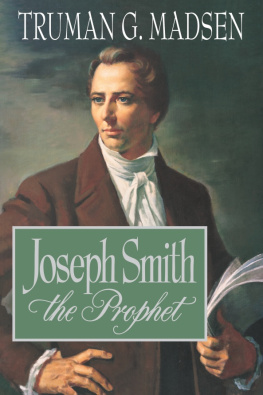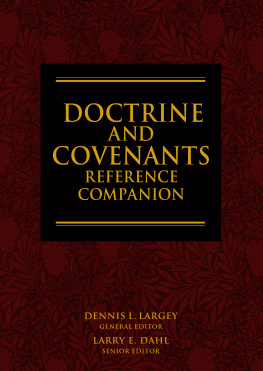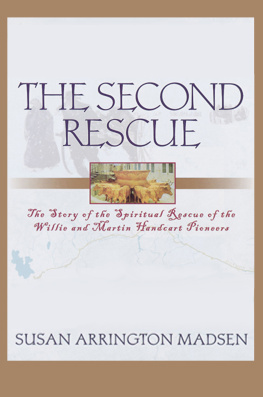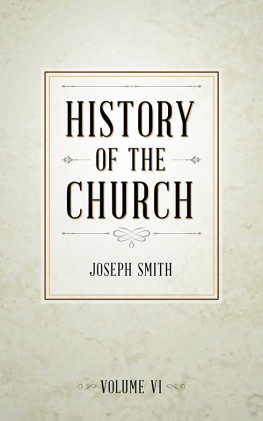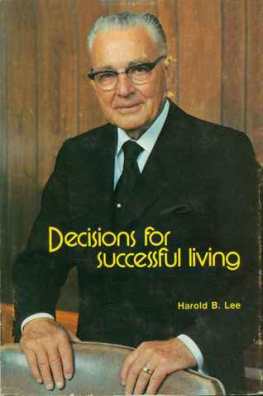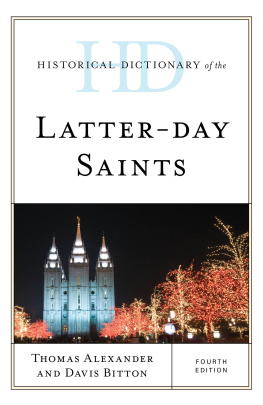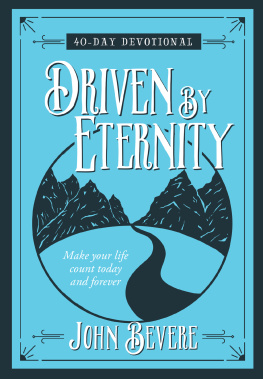Eternal Man
Truman G. Madsen
1966 Madsen G. Truman.
All rights reserved. No part of this book may be reproduced in any form or by any means without permission in writing from the publisher, Deseret Book Company, P.O. Box 30178, Salt Lake City Utah 84130. This work is not an official publication of The Church of Jesus Christ of Latter-day Saints. The views expressed herein are the responsibility of the author and do not necessarily represent the position of the Church or of Deseret Book. Deseret Book is a registered trademark of Deseret Book Company.
Introduction
In June, 1963, the first article of a memorable series was published in The Instructor magazine. As editors we were deeply concerned that our college-student readers might find orientation to basic philosophical problems through the insight of a scholar who knows the gospel as well as philosophy. We invited Truman G. Madsen. who holds his doctorate from Harvard University and who was serving as president of the New England Mission, to fill the role of author. Our first thought was a single article. Dr. Madsen submitted what is the first chapter of this book, entitled, "Whence Cometh Man???" Footnotes were not included, but they were made available by special request. Reader interest was intense and requests outstripped our limited supply. We then invited Brother Madsen to contribute six subsequent articles, one on each basic question raised in the original statement. We published complete notes for these in the magazine and received many letters from readers expressing appreciation.
The Instructor is pleased to encourage this reprint in book form for the same reasons that it published the original articles. Those reasons were set forth in the introduction which is reproduced here as follows:
President Truman G. Madsen writes both in the language of the churchman and of the philosopher. Some readers may prefer that the two viewpoints be kept separate; others may feel that the questions are beyond our adequate consideration. We grant that space is limited and that these "imponderables" have provoked volumes of argument. Yet, many serious students are reading widely today and are meeting the ideas of serious thinkers from antiquity to the present. They ask their Church leaders, "How do the arguments and positions of the various 'schools' of thought compare with the teachings of Joseph Smith and of the Restored Gospel?"
Brother Madsen answers this question, at least in part; and he does so with considerable penetration. He brings to this assignment a thorough scholarship of Church doctrine, plus an erudite schooling in philosophy, plus a deep inner conviction regarding the truthfulness of the Gospel of Jesus Christ. From this vantage point he directs the reader's attention to six basic "puzzles in philosophy and theology." He invites thinking and further study of these questions, and he challenges those whose reading may have missed the import of what some call "the long conversation." Leaders of youth need to know the ideas and language which their students meet in secular education. They need to study the arguments on basic philosophical issues. They need to understand the Gospel so that they can interpret it to these students and help them see things "of good report" in perspective.
It is to assist this serious study that we present this [introductory] articleone which we consider a notable milestone in our 97 years of publishing The Instructor.
LORIN F. WHEELWRIGHT
Associate Editor of The Instructor,
Published by the
Deseret Sunday School Union Board
Preface
The story behind these essays is still a matter of wonder in me. To a topic and title"Whence Cometh Man???"The Instructor editors added a hope. "It has been suggested," their letter said, "that you explain the meaning of premortality for some of the ultimate issues of human existence." Their intent was that I sketch in outline form the singular Mormon theme of pre-existence on the canvas of present-day philosophical approaches to man. So the effort was made.
The response was, to me at least, quite unforeseen. Not just teachers, whom we had expected to nudge toward wider application of their topics, but a variety of persons wrote for sources and further comparisons. Soon the editors asked that this article be the introduction to six others, around the issues barely broached within it: personal identity, creation, embodiment, freedom, suffering, and self-awareness. The query followed: "Will these be published in book form?" Till now I have answered, "No," convinced that interest would diminish. Instead it has increased.
Here, then, is the series, written as a kind of "midrash," a commentary on a theme. It can justly be said that they are not more than this, but not, I hope, that they are less. Letters of praise for their "objectivity" (which usually means that I have named and highlighted some of the live alternatives) miss my feeling that such merit as they have is in their subjectivity. Their primary gesture is toward inner echoes, toward, as it were, the nerve-endings of the spirit. For this reason, likewise, I am surprised at comments which assume I have proved or refuted this or that. The goal has been to clarify rather than to verify, with little room for argument, except an implicit appeal to introspection.
The concept of eternal man, with its refinements in the prophets of this new era, has an immense philosophical and theological strength which is only beginning to be recognized. But this, when presented adequately, will sponsor a tome which is not pressed for abbreviation.
It has been said more than once that the essays are hard to understand. If this reflects a struggle with the terms and the heavily packed style, my own children prove that these yield to repeated exposure. But another anxiety is involved here. Those who believe, as I do, in the magnificence of simplicity and the hazards of speculation wonder whether the statement of contrasts should be reduced or simply avoided.
Now it goes without saying that though the master writings of the Prophet are authoritative, my commentary is not. Concern for absolute fidelity to his intent has pushed me to original sources and to all the checking procedures I know. But if there is distortion I am not only open, but eager, for correction. Similarly, I must be alone responsible for interpretations of the other materials alluded to throughout.
But nothing here is willfully obscure. And it should be recognized that simplicity is not superficiality. The idea of a forever forward is not more or less simple than that of a forever backward. Yet, in our culture, one idea is commonplace, the other startling, even "unthinkable." (This retreat, it seems to me, is unavailable to those who say they understand the idea when it is applied to God.) My point is that there are deeps in man, and in the attempt to plumb him, depths which tax the most disciplined of minds, as also, which is much more, the most enlightened souls. I am with those who wish for a larger cup to grasp the ocean. But the Prophet, who was superb in making "the broad expanse of eternity" intelligible, warned that we do not enlarge the cup by a snap of the finger nor by a "fanciful, flowery and heated imagination;" only, he said, "by careful and ponderous and solemn thoughts." "By contrarieties," he added, "truth is made manifest."
A related kind of authority is needed in this realm. It is what, in the vernacular, is called "room to talk." It is hard come by. Academies help some, but life helps more.

